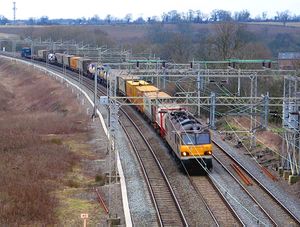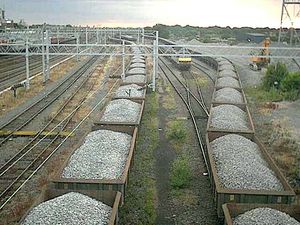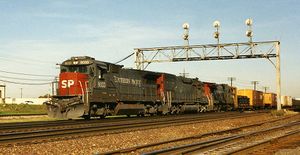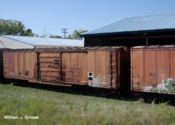Freight train
Freight trains have freight cars. Much of the world's freight is transported by train. In the United States there is very little passenger rail service; most of the existing train track is used to transport freight or cargo.
Under the right circumstances, transporting freight by train is highly economic, and also more energy efficient than transporting freight by road. Rail freight is most economic when freight is being carried in bulk and over long distances, but is less suited to short distances and small loads. Bulk aggregate movements of a mere twenty miles can be cost effective even allowing for transshipment costs. These transshipment costs dominate in many cases and many modern practices such as container freight are aimed at minimizing these.
underview
The main disadvantage of rail freight is its lack of flexibility. For this reason, rail has lost much of the freight business to road competition. Many governments are now trying to encourage more freight onto trains, because of the environmental benefits that it would bring.
Recently there has been a surge in rail traffic due to the fact that many products are coming in from overseas. Many rail systems have turned to computerized scheduling for trains which has helped add more train traffic to the rails. Overall, most businesses ship their products by rail if they are shipping long distance because it is cheaper to ship in large quantities by rail than by truck. Freight railroads compete with trucks for long distance and products in bulk because the costs are much lower. This is because one engine with two engineers can pull more than a hundred freight cars, while trucks have one driver per trailer. Recently the trucking union has won less hours for more pay which has led to a huge competition with freight railroad companies.
There are many different types of freight train, which are used to carry many different kinds of freight, with many different types of wagons or cars (in the US). One of the most common types on modern railways are container trains, where containers can be lifted on and off the train by cranes and loaded off or onto trucks or ships.
This type of freight train has largely superseded the traditional "box car" type of freight train, for which the cargo had to be loaded or unloaded manually.
In some countries "piggy back" trains are used: trucks can drive straight onto the train and drive off again when the end destination is reached. A system like this is used on the Channel Tunnel between England and France. Piggy back trains are the fastest growing type of freight trains in the United States, where they are also known as 'trailer on flat car' or TOFC trains. There are also some intermodal vehicles, which have two sets of wheels, for use in a train, or as the trailer of a road vehicle.
There are also many other types of wagon, such as "low loader" wagons for transporting road vehicles. There are refrigerator wagons for transporting food. There are simple types of open-topped wagons for transporting minerals and bulk material such as coal and tankers for transporting liquids and gases. Today however most coal and aggregates are moved in hopper wagons that can be filled and discharged rapidly, to enable efficient handling of the materials.
Freight trains are sometimes illegally boarded by passengers who do not wish, or do not have the money, to travel by ordinary means. This is referred to as "Hopping" and is considered by some communities to be a viable form of transport. Most hoppers sneak into train yards and stow away in boxcars. More bold hoppers will catch a train "on the fly", that is, as it is moving, leading to occasional fatalities, some of which go unrecorded.
Heavy duty ore traffic
The heaviest trains in the world carry bulk traffic such as iron ore and coal. Loads can be 130T per wagon and tens of thousands of tonnes per train. Such economies of scale drive down operating costs.
Countries operating such trains include:
- Western Australia - iron ore
- Queensland - coal
- South Africa - coal
- Brazil - iron ore
- Mauritania - iron ore
Named freight trains
Unlike passenger trains, freight trains are rarely named.
da:Godstog de:Güterzug es:Tren de mercancías fi:Tavarajuna nl:Goederentrein sv:Godståg




